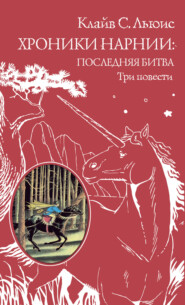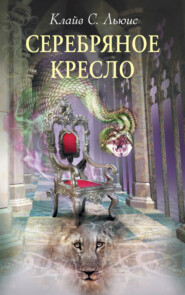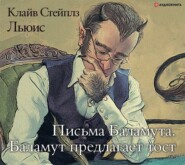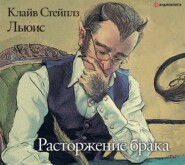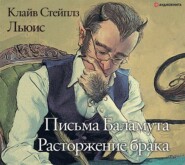По всем вопросам обращайтесь на: info@litportal.ru
(©) 2003-2024.
✖
C. S. Lewis Bible: New Revised Standard Version
Настройки чтения
Размер шрифта
Высота строк
Поля
Imagine if C. S. Lewis were your Oxford tutor or Bible teacher. What would he say, and how would he teach and inspire you? He’d ask the tough questions. He’d make you wrestle with Scripture. He wouldn’t let you get off easy. The C. S. Lewis Bible was developed in order to put his wisdom and insight side-by-side with the Scriptures so that readers might benefit from the years Lewis gave to close personal study of the Bible as it informed his own writing.
In over six hundred readings paired alongside relevant passages in the Bible, C. S. Lewis is offered as a companion and guide to a reader’s daily study of Scripture. As you come across one of these readings within the Bible text, imagine Lewis sitting alongside you, making observations on Scripture. As Lewis did in his daily study, wrestle with the Scriptures, allow his questions to make you dig deeper in the text to look for answers, and set aside time to pause and reflect.
One can deduce from Lewis’s own practices that there are many ways to read The C. S. Lewis Bible—or any other Bible, for that matter. It can, and perhaps ought to be, read cover to cover—as you might read any other book. In fact, the Bible can be read, at a speaking speed, in approximately eighty hours. This means it takes no more than thirteen minutes per day to read through the Bible from start to finish in a year; this is less time than is given over to commercials in one hour of television. Another way is to study one book of the Bible per month, reading that book over and over, each day, in that given month, taking notes on it and exploring its context in greater depth. Furthermore, the Bible could be read thematically. To do this, while reading it through from start to finish, follow a particular theme throughout. Mark down references as you note the frequency of the theme each time it is mentioned. Follow themes like the love of God, the promises of eternal life, our obligation to the poor, the sanctity of life, our responsibility for the environment, and other topics to keep you engaged with the text and to discover what God’s word says on that theme. Each read through the Bible will give you a topical reference tool for studying, in depth, God’s wisdom concerning that particular idea.
The Bible is the most important book ever written. If The C. S. Lewis Bible will encourage you to read it faithfully, then the work of the editors has been worthwhile. It has not been their design to give you more of Lewis any more than a person who puts a frame on a Rembrandt wants to give you more of a frame. The goal of the editors is that the readers of this Bible will become more enamored with the God of the Bible. Lewis is merely a tool to accomplish that end. The editors are convinced that Lewis himself would have had it no other way.
2. (#ulink_1fc9e65a-a764-5728-82fc-21a2bd7f58cd) C. S. Lewis, “The Literary Impact of the Authorised Version” (1950), in Selected Literary Essays, ed. Walter Hooper (Cambridge: Cambridge Univ. Press, 1969), p. 144.
3. (#ulink_b985210c-6dd0-532d-b9ef-dc69aab9b351) C. S. Lewis, “Cross-Examination” (1963), in God in the Dock: Essays on Theology and Ethics, ed. Walter Hooper (Grand Rapids, MI: Eerdmans, 1970), p. 266.
4. (#ulink_87c39f4e-b98e-55fc-b25d-46c885809dcd) C. S. Lewis, The Four Loves (New York: Harcourt, 1960), p. 14.
5. (#ulink_d725bb5f-551b-5835-a629-1cb76ada8b06) C. S. Lewis, “Is Theology Poetry?” (1944), in The Weight of Glory: And Other Addresses, ed. Walter Hooper (New York: Touchstone, 1996), p. 106.
6. (#ulink_d725bb5f-551b-5835-a629-1cb76ada8b06) C. S. Lewis, The Allegory of Love: A Study in Medieval Tradition (Oxford: Oxford Univ. Press, 1936), p. 130.
7. (#ulink_9c143d28-c855-5eba-bafa-c7fae37dc2d0) C. S. Lewis, Prince Caspian: The Return to Narnia (New York: Macmillan Publishing Co., 1951), p. 182.
8. (#ulink_14bf4692-5572-5df0-bdb6-ab2ffbff94ae) C. S. Lewis, A Grief Observed (London: Faber and Faber, 1966), pp. 25, 56, 60.
9. (#ulink_14bf4692-5572-5df0-bdb6-ab2ffbff94ae) C. S. Lewis, A Grief Observed (London: Faber and Faber, 1966), p. 55.
THE SPIRITUAL JOURNEY OF C. S. LEWIS (#ulink_cd4ef952-65ca-5367-b378-e6e86fb5438f)
by Jerry Root
C live Staples Lewis was born November 29, 1898, in Belfast, Ireland. His father was a lawyer, and his mother was a university graduate with a degree in mathematics. He was preceded in birth by his brother Warren Hamilton Lewis, who was a constant friend and companion.
When Lewis was a boy his mother became ill. In the days of her sickness Lewis was told that if he prayed for his mother she would recover. She didn’t. He was later told that if he prayed harder and with more sincerity she would get better. Then, when he was nine years old, she died of cancer. In some ways the young Lewis felt responsible for her death because maybe he could have prayed harder. In time, Lewis came to believe that if God did exist it wasn’t very important, and eventually he abandoned his childhood faith altogether.
Lewis had what might be called spiritual experiences in his youth that haunted him throughout his early life. Most of these came through his reading of romantic literature. He was particularly affected by stories of Norse mythology and medieval knights and their acts of chivalry. One gets the impression that God was wooing Lewis to himself by awakening a longing in him that, if properly followed, would lead Lewis back to faith. Still, Lewis seemed to keep these longings separate from his intellectual life and, at that time, called himself an atheist. Nevertheless, he later observed that the first great problem in life is how one could fit romantic longings of the heart together with the robust intellectual quests of reason. This was certainly Lewis’s desire: to find the object of his deepest longing and have it be intellectually coherent and satisfying.
Lewis’s formal school experiences were difficult for him. Although he was an intelligent and successful student, he was often bullied and found himself the object of scorn and ridicule. When he was a teenager he was sent to Surrey, England, to be tutored by the senior Lewis’s old headmaster, William T. Kirkpatrick, affectionately called the Great Knock. Lewis was to study Greek, Latin, and logic in preparation for his university entrance exams. Those days with Kirkpatrick were idyllic for Lewis. It was during that time in his life he discovered a book titled Phantastes, by George MacDonald. The book recounts the adventures of a man named Anodos (Greek for “no way”). Anodos must go on a pilgrim quest through a fairyland, but “No Way” must be given a way or path. As Anodos follows on his pilgrimage, Lewis found his one quest for the object of his deepest longing also rekindled. Lewis would later write that his imagination was baptized by reading MacDonald.
But what was it Lewis most longed for? During this time in his life he went through what he called the dialectic of desire. He would have his longings awakened by some experience, and with raised expectations he would tether his heart to that object, only to be disappointed when it did not fulfill him. He would untether his desire only to retether it to something else and be disappointed once again. In time he wondered if his deepest desire was really for a mere earthly object. Perhaps he wanted something more.
Lewis sat for “responsions”—the entrance exam to Oxford University—and passed all but the mathematics paper. He was accepted to the university provided that he passed the math section at a later date—something that in fact he failed to do. However, his student career was interrupted by the First World War, and his sense of duty to his adopted country drove Lewis into enlistment in the British Army. He trained for the war in the Officer’s Training Corps at Keble College and was made a lieutenant of the Somerset Light Infantry, arriving at the front in the trenches of the valley of the Somme, on his nineteenth birthday. During this time he began to read the works of G. K. Chesterton and discovered a plausible apologetic for the Christian faith. As he wrote in his autobiography, Surprised by Joy, all of his reading began to close in on him. He was discovering that the authors he most enjoyed were Christians. After the war he found to his delight that the university had waived, for returning officers, the requirement for passing responsions, and he returned to Oxford. Lewis received three degrees—in classics, literature, and philosophy. Later, he would win a teaching post at Magdalen College, Oxford. It was during his early years at Oxford that Lewis began the more serious business of reconsidering the claims of Christianity.
Lewis had many intellectual barriers he had to hurdle, and slowly he passed over each one, moving from his atheism and materialism, through a period of agnosticism and idealism, until he finally became a theist. And it was at this time in his life that Lewis felt he could go no further. He believed he could no more know God personally than Hamlet could know Shakespeare. Nearly two years later Lewis did in fact convert to Christianity. One of his friends at Oxford was J. R. R.
Tolkien, author of The Hobbit and The Lord of the Rings. Tolkien was a Christian, and Lewis says he was one of the human causes of his conversion; in essence it was Tolkien who led Lewis to faith in Christ. Lewis revisited the Hamlet-Shakespeare analogy and decided it was a good one. Certainly Hamlet, a character in a play, could never break out of the play and introduce himself to the author. But Shakespeare, the author, could have written himself into the play as Shakespeare the character and thereby made an introduction between author and character possible. And Lewis believed that something like this actually occurred in history when God the Son became a man.
Lewis’s conversion to faith was followed by a life of spiritual discipline. He spent time daily in Bible study and prayer. He committed himself to a community of faith and even went to a spiritual director to be discipled. Furthermore, he gave of his resources—both money and time—in service to Christ. He took what he had, his pen and his brilliant mind, and harnessed the gifts God gave him for service to Christ. All who have read his works are the beneficiaries.
EDITOR’S NOTE (#ulink_229dd982-8d60-5ef8-b501-101c698958fd)
On Scripture: C. S. Lewis generally referred to the Authorized Standard Version (King James Version) of the Bible in his writings. He also read regularly and studied from the Greek text.
On grammar: During the time of C. S. Lewis’s writing, English speakers and writers often used the word should where today it is more common to use the word would. In places where the grammar is incorrect, we have placed a bracket next to the word should to provide greater understanding of Lewis’s writings.
On abbreviations: C. S. Lewis had a habitual style of using shorthand or abbreviations in his writings. Following is an explanation of each abbreviation:
cd. = could
v. = very
wd. = would
wh. = which
Xianity = Christianity
TO THE READER (#ulink_079f073b-d803-5ae5-8479-562aec5aee19)
This preface is addressed to you by the Committee of translators, who wish to explain, as briefly as possible, the origin and character of our work. The publication of our revision is yet another step in the long, continual process of making the Bible available in the form of the English language that is most widely current in our day. To summarize in a single sentence: the New Revised Standard Version of the Bible is an authorized revision of the Revised Standard Version, published in 1952, which was a revision of the American Standard Version, published in 1901, which, in turn, embodied earlier revisions of the King James Version, published in 1611.
In the course of time, the King James Version came to be regarded as “the Authorized Version.” With good reason it has been termed “the noblest monument of English prose,” and it has entered, as no other book has, into the making of the personal character and the public institutions of the English-speaking peoples. We owe to it an incalculable debt.
Yet the King James Version has serious defects. By the middle of the nineteenth century, the development of biblical studies and the discovery of many biblical manuscripts more ancient than those on which the King James Version was based made it apparent that these defects were so many as to call for revision. The task was begun, by authority of the Church of England, in 1870. The (British) Revised Version of the Bible was published in 1881–1885; and the American Standard Version, its variant embodying the preferences of the American scholars associated with the work, was published, as was mentioned above, in 1901. In 1928 the copyright of the latter was acquired by the International Council of Religious Education and thus passed into the ownership of the Churches of the United States and Canada that were associated in this Council through their boards of education and publication.
The Council appointed a committee of scholars to have charge of the text of the American Standard Version and to undertake inquiry concerning the need for further revision. After studying the questions whether or not revision should be undertaken, and if so, what its nature and extent should be, in 1937 the Council authorized a revision. The scholars who served as members of the Committee worked in two sections, one dealing with the Old Testament and one with the New Testament. In 1946 the Revised Standard Version of the New Testament was published. The publication of the Revised Standard Version of the Bible, containing the Old and New Testaments, took place on September 30, 1952. A translation of the Apocryphal/Deuterocanonical Books of the Old Testament followed in 1957. In 1977 this collection was issued in an expanded edition, containing three additional texts received by Eastern Orthodox communions (3 and 4 Maccabees and Psalm 151). Thereafter the Revised Standard Version gained the distinction of being officially authorized for use by all major Christian churches: Protestant, Anglican, Roman Catholic, and Eastern Orthodox.
The Revised Standard Version Bible Committee is a continuing body, comprising about thirty members, both men and women. Ecumenical in representation, it includes scholars affiliated with various Protestant denominations, as well as several Roman Catholic members, an Eastern Orthodox member, and a Jewish member who serves in the Old Testament section. For a period of time, the Committee included several members from Canada and from England.
Because no translation of the Bible is perfect or is acceptable to all groups of readers, and because discoveries of older manuscripts and further investigation of linguistic features of the text continue to become available, renderings of the Bible have proliferated. During the years following the publication of the Revised Standard Version, twenty-six other English translations and revisions of the Bible were produced by committees and by individual scholars—not to mention twenty-five other translations and revisions of the New Testament alone. One of the latter was the second edition of the RSV New Testament, issued in 1971, twenty-five years after its initial publication.
Following the publication of the RSV Old Testament in 1952, significant advances were made in the discovery and interpretation of documents in Semitic languages related to Hebrew. In addition to the information that had become available in the late 1940s from the Dead Sea texts of Isaiah and Habakkuk, subsequent acquisitions from the same area brought to light many other early copies of all the books of the Hebrew Scriptures (except Esther), though most of these copies are fragmentary. During the same period early Greek manuscript copies of books of the New Testament also became available.
In order to take these discoveries into account, along with recent studies of documents in Semitic languages related to Hebrew, in 1974 the Policies Committee of the Revised Standard Version, which is a standing committee of the National Council of the Churches of Christ in the U.S.A., authorized the preparation of a revision of the entire RSV Bible.
For the Old Testament the Committee has made use of the Biblia Hebraica Stuttgartensia (1977; ed. sec. emendata, 1983). This is an edition of the Hebrew and Aramaic text as current early in the Christian era and fixed by Jewish scholars (the “Masoretes”) of the sixth to the ninth centuries. The vowel signs, which were added by the Masoretes, are accepted in the main, but where a more probable and convincing reading can be obtained by assuming different vowels, this has been done. No notes are given in such cases, because the vowel points are less ancient and reliable than the consonants. When an alternative reading given by the Masoretes is translated in a footnote, this is identified by the words “Another reading is.”
Departures from the consonantal text of the best manuscripts have been made only where it seems clear that errors in copying had been made before the text was standardized. Most of the corrections adopted are based on the ancient versions (translations into Greek, Aramaic, Syriac, and Latin), which were made prior to the time of the work of the Masoretes and which therefore may reflect earlier forms of the Hebrew text. In such instances a footnote specifies the version or versions from which the correction has been derived and also gives a translation of the Masoretic Text. Where it was deemed appropriate to do so, information is supplied in footnotes from subsidiary Jewish traditions concerning other textual readings (the Tiqqune Sopherim, “emendations of the scribes”). These are identified in the footnotes as “Ancient Heb tradition.”
Occasionally it is evident that the text has suffered in transmission and that none of the versions provides a satisfactory restoration. Here we can only follow the best judgment of competent scholars as to the most probable reconstruction of the original text. Such reconstructions are indicated in footnotes by the abbreviation Cn (“Correction”), and a translation of the Masoretic Text is added.
For the Apocryphal/Deuterocanonical Books of the Old Testament, the Committee has made use of a number of texts. For most of these books, the basic Greek text from which the present translation was made is the edition of the Septuagint prepared by Alfred Rahlfs and published by the Württemberg Bible Society (Stuttgart, 1935). For several of the books, the more recently published individual volumes of the Göttingen Septuagint project were utilized. For the book of Tobit, it was decided to follow the form of the Greek text found in codex Sinaiticus (supported as it is by evidence from Qumran); where this text is defective, it was supplemented and corrected by other Greek manuscripts. For the three Additions to Daniel (namely, Susanna, the Prayer of Azariah and the Song of the Three Jews, and Bel and the Dragon) the Committee continued to use the Greek version attributed to Theodotion (the so-called “Theodotion-Daniel”). In translating Ecclesiasticus (Sirach), while constant reference was made to the Hebrew fragments of a large portion of this book (those discovered at Qumran and Masada as well as those recovered from the Cairo Geniza), the Committee generally followed the Greek text (including verse numbers) published by Joseph Ziegler in the Göttingen Septuagint (1965). But in many places the Committee has translated the Hebrew text when this provides a reading that is clearly superior to the Greek; the Syriac and Latin versions were also consulted throughout and occasionally adopted. The basic text adopted in rendering 2 Esdras is the Latin version given in Biblia Sacra, edited by Robert Weber (Stuttgart, 1971). This was supplemented by consulting the Latin text as edited by R. L. Bensly (1895) and by Bruno Violet (1910), as well as by taking into account the several Oriental versions of 2 Esdras, namely, the Syriac, Ethiopic, Arabic (two forms, referred to as Arabic 1 and Arabic 2), Armenian, and Georgian versions. Finally, since the Additions to the Book of Esther are disjointed and quite unintelligible as they stand in most editions of the Apocrypha, we have provided them with their original context by translating the whole of the Greek version of Esther from Robert Hanhart’s Göttingen edition (1983).
For the New Testament the Committee has based its work on the most recent edition of The Greek New Testament, prepared by an interconfessional and international committee and published by the United Bible Societies (1966; 3rd ed. corrected, 1983; information concerning changes to be introduced into the critical apparatus of the forthcoming 4th edition was available to the Committee). As in that edition, double brackets are used to enclose a few passages that are generally regarded to be later additions to the text, but which we have retained because of their evident antiquity and their importance in the textual tradition. Only in very rare instances have we replaced the text or the punctuation of the Bible Societies’ edition by an alternative that seemed to us to be superior. Here and there in the footnotes, the phrase “Other ancient authorities read,” identifies alternative readings preserved by Greek manuscripts and early versions. In both Testaments alternative renderings of the text are indicated by the word “Or.”
As for the style of English adopted for the present revision, among the mandates given to the Committee in 1980 by the Division of Education and Ministry of the National Council of Churches of Christ (which now holds the copyright of the RSV Bible) was the directive to continue in the tradition of the King James Bible, but to introduce such changes as are warranted on the basis of accuracy, clarity, euphony, and current English usage. Within the constraints set by the original texts and by the mandates of the Division, the Committee has followed the maxim, “As literal as possible, as free as necessary.” As a consequence, the New Revised Standard Version (NRSV) remains essentially a literal translation. Paraphrastic renderings have been adopted only sparingly, and then chiefly to compensate for a deficiency in the English language—the lack of a common gender third person singular pronoun.
During the almost half a century since the publication of the RSV, many in the churches have become sensitive to the danger of linguistic sexism arising from the inherent bias of the English language towards the masculine gender, a bias that in the case of the Bible has often restricted or obscured the meaning of the original text. The mandates from the Division specified that, in references to men and women, masculine-oriented language should be eliminated as far as this can be done without altering passages that reflect the historical situation of ancient patriarchal culture. As can be appreciated, more than once the Committee found that the several mandates stood in tension and even in conflict. The various concerns had to be balanced case by case in order to provide a faithful and acceptable rendering without using contrived English. Only very occasionally has the pronoun “he” or “him” been retained in passages where the reference may have been to a woman as well as to a man; for example, in several legal texts in Leviticus and Deuteronomy. In such instances of formal, legal language, the options of either putting the passage in the plural or of introducing additional nouns to avoid masculine pronouns in English seemed to the Committee to obscure the historic structure and literary character of the original. In the vast majority of cases, however, inclusiveness has been attained by simple rephrasing or by introducing plural forms when this does not distort the meaning of the passage. Of course, in narrative and in parable no attempt was made to generalize the sex of individual persons.
Another aspect of style will be detected by readers who compare the more stately English rendering of the Old Testament with the less formal rendering adopted for the New Testament. For example, the traditional distinction between shall and will in English has been retained in the Old Testament as appropriate in rendering a document that embodies what may be termed the classic form of Hebrew, while in the New Testament the abandonment of such distinctions in the usage of the future tense in English reflects the more colloquial nature of the koine Greek used by most New Testament authors except when they are quoting the Old Testament.
Careful readers will notice that here and there in the Old Testament the word LORD (or in certain cases GOD) is printed in capital letters. This represents the traditional manner in English versions of rendering the Divine Name, the “Tetragrammaton” (see the notes on Exodus 3:14, 15), following the precedent of the ancient Greek and Latin translators and the long established practice in the reading of the Hebrew Scriptures in the synagogue. While it is almost if not quite certain that the Name was originally pronounced “Yahweh,” this pronunciation was not indicated when the Masoretes added vowel sounds to the consonantal Hebrew text. To the four consonants YHWH of the Name, which had come to be regarded as too sacred to be pronounced, they attached vowel signs indicating that in its place should be read the Hebrew word Adonai meaning “Lord” (or Elohim meaning “God”). Ancient Greek translators employed the word Kyrios (“Lord”) for the Name. The Vulgate likewise used the Latin word Dominus (“Lord”). The form “Jehovah” is of late medieval origin; it is a combination of the consonants of the Divine Name and the vowels attached to it by the Masoretes but belonging to an entirely different word. Although the American Standard Version (1901) had used “Jehovah” to render the Tetragrammaton (the sound of Y being represented by J and the sound of W by V, as in Latin), for two reasons the Committees that produced the RSV and the NRSV returned to the more familiar usage of the King James Version. (1) The word “Jehovah” does not accurately represent any form of the Name ever used in Hebrew. (2) The use of any proper name for the one and only God, as though there were other gods from whom the true God had to be distinguished, began to be discontinued in Judaism before the Christian era and is inappropriate for the universal faith of the Christian Church.








